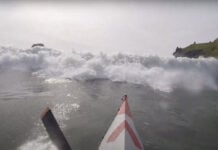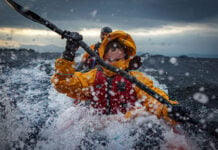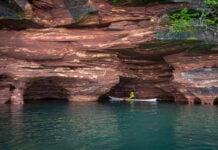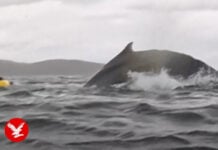It took five years, but last fall the International Whitewater Hall of Fame made good on its claims of being truly international by inducting six influential whitewater paddlers and advocates from around the globe. Among them was Canada’s first inductee, Song of the Paddle author Bill Mason.
Bill Mason was a humble paddler
Mason is most easily imagined clad in his trademark plaid shirt and denim cut-offs, crouching beside a campfire above a rapid—the kind of rapid canoeists who came before Mason would be fearful of, and the same kind that canoeists began to search out for fun shortly after Mason produced his two classic books and many films.
But was this just an accident of timing? Is the man really Hall of Fame material?
Singing the song of the paddle
Mason himself was humble about his whitewater skills. It’s hard to imagine any of today’s pro paddlers asking searching questions on their blogs, as Mason did in his guide to canoe tripping, Song of the Paddle: “When you swim as much as I do, you have to ask, ‘Why?’”
The reason had nothing to do with being overly aggressive. In a section titled Descending a River with a Current, Mason sums up a lesson on “Rounding a Bend with a Back Ferry” with this reminder: “Take note that I haven’t said anything about paddling downstream; we’ve been drifting. Only a few strokes forward or back are necessary to correct our position in the current and maintain complete control.”
“When you swim as much as I do,
you have to ask, ‘Why?’”
Get the throw rope ready
That’s not to say that Mason thought whitewater had to be a joyless experience. “Extreme back ferries and reverse entries into eddies can be a lot of fun,” he affirms later.
He also devotes a whole section in Song of the Paddle to the “aggressive, faster-than-the-current technique” employed by “hot doggers” and explains manoeuvres like powering through haystacks, crashing through rollers, doing enders and something he calls “trashing in the surf.”
There are paddlers now pushing middle age who took to the water after Mason published Song and his seminal first book, Path of the Paddle. They are of a generation that has become used to seeing videos in which talented filmmakers make daring paddlers look superhuman. By comparison, the cover photo of Mason with his white beard, collared lifejacket, floppy wide brimmed hat and cedar canoe might seem a little—what’s the word—lame.
Inspiring the next generation
Mason died in 1988, and probably would have swallowed his floppy hat if he had seen footage of Tyler Bradt’s 186-foot waterfall drop last year.
Finding the line between Mason’s cautious approach and Bradt’s freefall would take a lot of scouting, a lot of time looking at whitewater. It’s not an obvious line—but rather one that might involve a few slow-motion back ferries and maybe some unnecessary eddying out.
Bradt spent almost no time “trashing in the surf” at the bottom of his drop. That may be because he thinks that trick is lame. He might be right. But the difference between Bradt and Mason’s paddling styles is that Mason learned about rapids from reading books about the voyageurs. Paddlers of Bradt’s generation grew up reading books by Bill Mason.
Bill Mason belongs in the Hall
Mason wasn’t flashy, but he was good at getting to where he wanted to be—where he belonged. That goes for tight eddies halfway down Rollaway Rapid, and Song of the Paddle‘s spot on library shelves. It equally goes for his rightful place in the Whitewater Hall of Fame.
This article was first published in the Spring 2010 issue of Rapid Magazine. Subscribe to Paddling Magazine’s print and digital editions, or browse the archives.








